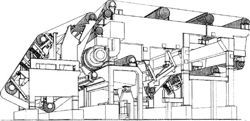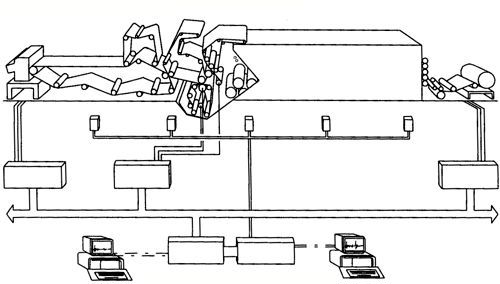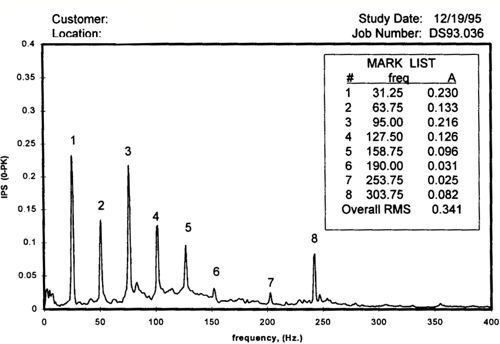Planning roll maintenance yields the best uptime and efficiency
May 3, 2022

Paper machine rolls are the most numerous and often the most complicated components of the machine. Standards of performance for paper machine rolls are higher, making maintenance increasingly important in several areas:
- Rolls with working internals must be capable of sustained consistent high performance.
- Vibration sensing equipment is used to monitor bearing condition to prevent downtime and achieve maximum life.
- Roll surface condition and crowns must be maintained for higher product quality.
- Rolls must be balanced for higher speeds.

Vibration monitoring system
The standards of performance have to be maintained to compete in today’s world market. Paper machine efficiency and product quality depend directly on roll maintenance.
In addition to the requirement that rolls be maintained to give acceptable standards of performance, the maintenance program must be cost effective as well. Both product quality and cost effectiveness are necessary to promote something very dear to all of us: Job Security.
Principles of maintenance
There are four approaches you can take to maintenance programs.
Reactive, also called corrective, run to failure, or fix it when it breaks. This will maximize the run time between repairs but it is also costly as unplanned shutdowns equal lost production and you must gather parts and people at the last minute. You need to stock more spare parts as you do not know what will break, when it will break and, if a catastrophic failure occurs, other components will be damaged. This is also considered dangerous and affects off quality production.
Routine preemptive wear repair, replacement or overhaul is done based on a schedule. Component life is determined by theory and experience. The problem here is that machines do not always follow schedules and this leads to needless repairs or failures ahead of schedule.
Preventive maintenance that maximizes component life through lubrication, alignment and roll grinding or balancing. This will extend the component life but does not prevent failure. Preventive maintenance can be compared to preventive medicine, the only
difference is the type of patient.
Predictive maintenance that is based on observation or measurement of the machine condition. This is performed while the machine is running versus while the machine is down. It includes vibration analysis, temperature and lube oil checks, visual (stroboscope) and audible (stethoscope). Combined with preventive maintenance, this is the best approach because it maximizes up time, improves quality and prevents catastrophes.

Vibration analysis readout
Maintenance planning
Maintenance - either scheduled or unscheduled - is an essential aspect of paper mill operations. It must be done and its cost is the price you pay for efficiency. The maintenance department is expected to maintain rolls so that they operate at the highest speed possible, for the longest period possible between shutdowns; and the shutdown itself must be as short in time as possible.
It is usually much easier and less time consuming to remove a completely assembled roll in need of repair and install a new unit than it is to attempt to make the repairs during a shut down. The repairs can then be done with attention to detail under the best possible conditions while the machine is running.
There are cases however, when this is not possible, such as when there is no spare available.
It is important that records are kept regarding the condition of rolls as they are removed from the machine and again when they have been refurbished and are again installed in the machine. These records help you analyze a reoccurring problem or operating conditions that are causing poor operating efficiency of the paper machine. Press and calender rolls are prime examples where good and accurate record keeping can help with solutions to operating problems.
When planning roll maintenance work to be done during a shutdown, there can be many jobs which interrelate, and the best way to coordinate is to plot them out.
One way of doing this is with a bar chart. This is particularly important when operations or the complete job depends on outside vendors or factory services.
With the sequence and timing thus indicated, those involved in the repair operations and those depending on the completion time have a graphic picture of how the work will progress.
Considerations for planned shutdown roll repairs
- Can some of the work be done in advance?
- Are enough tradesmen available with the expertise necessary to do what needs to be done in the time allowed?
- Is the proper equipment and material needed on hand?
- Do the vendors and outside contractors involved have the resources to supply the services required?
- Are the drawings and other reference materials on hand?
- What problems should be considered?
A meeting should be held with key personnel that are involved in the shutdown. There should be one coordinator and they should use the chart to coordinate the various activities according to their proper sequence. The coordinator would also monitor the efforts of the vendors and service people who do not attend the scheduling meeting. Items that should be discussed in the meeting include:
- Identify the critical item that will affect the starting time of the machine.
- Make sure that the critical item is worked on continuously and with sufficient manpower so as to keep the downtime as short as possible.
- Identify the float period in any job sequence that can be allowed before that particular part becomes the new critical item and holds up the machine starting time.
- Show the sequence for using overhead cranes for the most efficient usage.
- Identify what operations have to be completed before other operations can start, so that the progress can be monitored easily and the job not be allowed to hold up the start of the next task.
- Coordinate all groups involved with a particular piece of equipment so that when the duties of one group are finished, the next group involved can start immediately without delay.
- Obtain a realistic start-up time, so that the progress and thoroughness of inspections and repairs can be gauged accordingly.
- Give the machine operating crew sufficient warning time to allow for proper steaming of dryers and running of calender stacks.
- Provide a guide for decision making that gives maximum flexibility. Sometimes due to unexpected developments, the order of jobs can be changed for maximum efficiency in the completion of the shutdown or project. The effects of these changes can be plainly visible with a bar chart.
NOTE: The installation and removal of mill maintenance crew safety locks can cause serious delays if not watched closely.
Summary
The maintenance departments of today’s paper mills have become more than a machine shop of the past. To keep the machine operating for longer periods of time and on-machine downtime at a minimum, the maintenance person must:
- Plan and schedule activities.
- Keep accurate records.
- Be trained to work on complicated equipment.
- Understand how equipment works and how to troubleshoot.
- Have the right supplies and tools.
- Know how to use machine drawings.
- Understand how to communicate.
- Have a reliable method of stocking spare parts and material.
- Make use of up-to-date diagnostic equipment.
- Know when to ask for factory service.
- Observe all aspects of the system.
For assistance with your roll maintenance process, contact your Valmet representative.